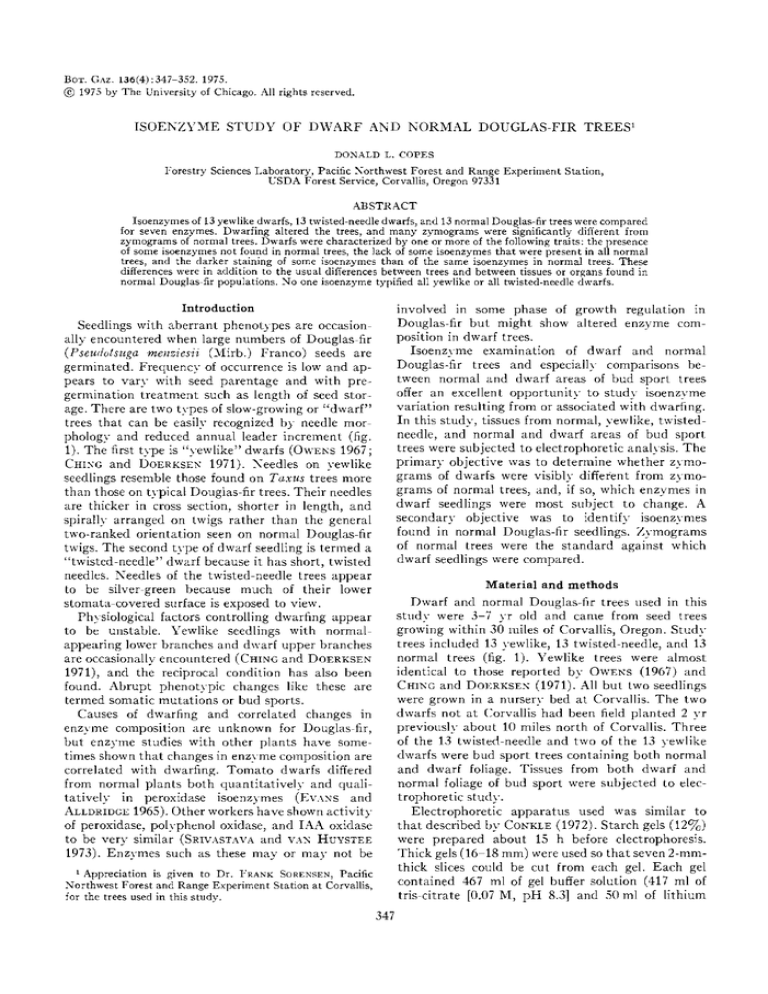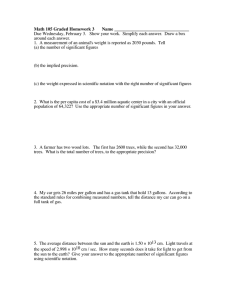
BOT. GAZ.136(4): 347-352. 1975.
(h) 1975 by The University of Chicago. All rights reserved.
ISOEN%YME
STUDY
OF DWARF
AND
NORMAL
DOUGLAS-FIR
TREES1
DONALD L. COPES
Forestry Sciences Laboratory, Pacific Northwest Forest and Range Experiment Station
USDA Forest Service, Corvallis, Oregon 97331
ABSTRACT
Isoenzymes of 13 yewlike dwarfs, 13 twisted-needle dwarfs, and 13 normal Douglas-fir trees were compared
for seven enzymes. Dwarfing altered the trees, and many zymograms were significantly different from
zymograms of normal trees. Dwarfs were characterized by one or more of the following traits: the presence
of some isoenzymes not found in normal trees, the lack of some isoenzymes that were present in all normal
trees, and the darker staining of some isoenzymes than of the same isoenzymes in normal trees. These
differences were in addition to the usual differences between trees and between tissues or organs found in
normal Douglas-fir populations. No one isoenzyme typified all yewlike or all twisted-needle dwarfs.
Introduction
Seedlings with aberrant phenotypes are occasionally encountered when large numbers of Douglas-fir
(Pseu(lotsuga menziesii (Mirb.) Franco) seeds are
germinated. Frequency of occurrenceis low and appears to vary with seed parentage and with pregermination treatment such as length of seed storage. There are two types of slow-growingor "dwarf"
trees that can be easilv recognized b) needle morphology and reduced annual leader increment (fig.
1). The first type is "yewlike" dwarfs (OWENS1967;
CH1NGand DOERKSEN
1971). Needles on yewlike
seedlings resemble those found on Taxus trees more
than those on typical Douglas-firtrees. Their needles
are thicker in cross section, shorter in length, and
spira]ly arranged on twigs rather than the general
two-ranked orientation seen on normal Douglas-fir
twigs. The second tYpe of dwarf seedling is termed a
"twisted-needle"dwarf because it has short, twisted
needles. Needles of the twisted-needle trees appear
to be silver-green because much of their lower
stomata-covered surface is exposed to view.
Physiological factors controlling dwarfing appear
to be unstable. Yewlike seedlings with normalappearinglower branches and dwarf upper branches
are occasionallyencountered (CHINGand DOERKSEN
1971), and the reciprocal condition has also been
found. Abrupt phenotypic changes like these are
termed somatic mutations or bud sports.
Causes of dwarfing and correlated changes in
enzyme composition are unknown for Douglas-fir,
but enzyme studies with other plants have sometimes shown that changes in enzvme composition are
correlated with dwarfing. Tomato dwarfs differed
from normal plants both quantitatively and qualitatively in peroxidase isoen%ymes (EV.\NS and
ALLDRIDGE
1965) . 0th er workershave shown activit
of peroxidase, polvphenol oxidase, and IAA oxidase
to be very similar (SRIVASTAVA
and VANHUYSTEE
1973). Enzymes such as these may or may not be
1 Appreciation is given to Dr. FRANKSORENSEN,Pacific
Northwest Forest and Range Experiment Station at Corvallis,
for the trees used in this study.
347
involved in some phase of growth regulation in
Douglas-fir but might show altered enzyme composition in dwarf trees.
Isoenzyme examination of dwarf and normal
Douglas-fir trees and especially comparisons between normal and dwarf areas of bud sport trees
offer an excellent opportunity to study isoenzyme
variation resulting from or associated with dwarfing.
In this study, tissues from normal, vewlike, twistedneedle, and normal and dwarf areas of bud sport
trees were subjected to electrophoreticanalysis. The
primary objective was to deterIlline whether zymograms of dwarfs were visibly different from zymograms of normal trees, and, if so, which enzymes in
dwarf seedlings were most subject to change. A
secondary objective was to identify isoenzymes
found in normal Douglas-fir seedlings. Zymograms
of normal trees were the standard against which
dwarf seedlings were compared.
Material and methods
Dwarf and normal Douglas-fir trees used in this
stud were 3-7 yr old and canze from seed trees
growing within 30 llliles of Corvallis, Oregon. Studx
trees included 13 vewlike, 13 twisted-needle, and 13
normal trees (fig. 1). Yewlike trees were almost
identical to those reported by OWENS(1967) and
CH1NG
and DOERKSEN
(1971). All but two seedlings
were grown in a nursery bed at Corvallis. The two
dwarfs not at Corvallis had been field planted 2 yr
previouslv about 10 miles north of Corvallis. Three
of the 13 twisted-needle and two of the 13 yewlike
dwarfs were bud sport trees containing both normal
and dwarf foliage. Tissues from both dwarf and
normal foliage of bud sport were subjected to electrophoreticstudy.
Electrophoretic apparatus used was similar to
that describedbv CONKLE
(1972). Starch gels (12%o)
were prepared about 15 h before electrophoresis.
Thick gels (16-18 mm) wereused so that seven 2-mmthick slices could be cut from each gel. Each gel
contained 467 ml of gel buffer solution (417 ml of
tris-citrate [0.07 M, pH 8.3] and 50 ml of lithium
_*{,
=;
. LmE
CZ
|available,
- _;
S 1Peroxidase,
were
9 _1-_
"acid
diagrams
! scales
_Tree
absorbed
(perlderm
1973
phosphatase,
not
branches
of
and
cytochrome
removed)
| because
the
January
on
to paper
isoenzvme
lnner
werewere
glutamate
thev
24,
oxidase,
collected
Bcamblal
wicks
1974.
macerated
arepatterns
known
(5
Samples
dehvdrogenase,
zone),
catalase,
theX. in
13
day
to
were
from
and
two
mm,
before
be esterase,
drawn
about
each
to
involved
Whatman
eight
electree
and
and
50L
$.
s2 =
g
.
xW_R..
.
-,
_
348
BOTANICALGAZETTE
A
t
t
.t. ;t£
W
_
:| 1
t
S
g
1 11 li* ||X_
*| ii 11
-
11| i 211
i
>
-
!S
,,
F
gi_
^ SX11S
E:e
borate [0.25M, pH 7.4]) with 56 g of hydro]yzed
starch. The electrode buffer was lithium borate
(0.25M,pH 7.4). Electrophoresis
was performedat
8 C for 2-2.25 h with a constantcurrentof 100mA
7.6 mA/cm). The borate front traveled 8 cm towardthe anodeduringthat time. Vo]tageincreased
duringthe runfrom230 to 550V.
-
E
_3
_
D
about 500mg of needles,about 250mg of bark
1
75 mg of vegetative bud meristems (with bud
_
-
N
1
e
u
_
_
drops of gel buffer solution containing5SOpolyvinvlpsrrolidone(MW40,000).Only tissuesformed
in 1973weremacerated.The maceratedplant fluids
II
no. 1 chromatography
paper).
Four gels werepreparedfor each electrophoretic
run.Eachgel contained18 or 21 wicks(six or seven
trees). Wickswith extractsfromneedles,bark,and
buds of each tree wereplacedln the same gels. In
each electrophoretic
run, trees studiedat that date
werereplicatedoncein twogels.Two electrophoretic
runs were made for every tree, so each tree was
tested in fourdifferentgels.
XL
..1
*
b|
*
<
^>*
a
a
Eij
t
t v
_
l
^
leucineaminopeptidase
(LAP)wereselectedbecause
workablemethodsof deteeting these enzymes are
-^
t
_5^
in growthregulation.Peroxidase,acid phosphatase,
esterase,and LAP visualizationfollowedthe proceduresdescribedb)SCAND.ALIOS
(1969).Glutamate
dehdrogenaseand catalaseweredetectedbv methods describedbw SHAWand PRASAD(1970). Cvtochromeoxidasewas detected with the method reportedby MOLNAR
and LACROIX(1972). Detailed
_
. j
s
<
:
^
photographsmadeof eachgel. Bandpositionsin this
paperareexpressedas relativemobility,Rm values:
the distancethat the isoenzymehad migratedfrom
the origin,dividedby the distancethe boratefront
had movedfrom the origintowardthe anode.The
only cathodicbandsreportedwerethreeperoxidase
and cytochromeoxidaseisoenzymes.All other Rm
valuesapplyto anodicbands.
{
t
i
i<S
@.
w
3E
^ai
i^s<
-9
k
>
_
- -^
'@
4_t
^--s
_f>
lf
LR
:_
_
l
E
.F fl
,^
_
1
ES
F)
,
}4s
of 7-yr-old yewllke (A), 3-yr-old
normal (B), and 7-yr-old twisted-needle(C) trees showing
characteristicneedleand crowntraits.
F IG.
1.-Photographs
trophoresis.Storagewas at 0 C in plasticbags.Electrophoreticruns were made betweenDecember6,
Results
A summationof the isoenzymesfoundin needles,
bark, and vegetatlvebud merlstemsof 13 normal
Douglas-firtreesis presentedin figure2. These isoenzymeswere used as the standardagainst which
isoenzymesfrom dwarf trees were compared.In
figure3, isoenzymesfromdwarfsthat were significantly dlfferentfrom those found ln normaltrees
are presented.Isoenzymesthat did not appearin
--
RELATIVE
MOBILITY
(Rm)
Anode
Catalase
-
-
-
-
-
--
-
Peroxidase and
Acid
Glutanic
Leuci
cytochrome
phosphatase dehydrogenaseaminopep
oxidase
N B M N B M N BM N B M N B
1.00,.90
.70
-
-
.60
.50-
=
-
b
"
.40
n
10n
-
-
-.10,
-.20
-.30
-.40Cathode
2.-Zymograms of normalDouglas-firneedles(N), bark (B), and vegetative meristems(M) sampledfrom D
24; 1974.Heavy shadinginclicatesdark-stainedbands;dashedline indicatesvery lightly stainedbands,and interme
that staineddarkerthan those indicatedby dashedline but less dark than those indicatedby heavy shading.
FIG.
RELATIVE
MOBILITY
{Rm}
Catalase
Peroxidaseand
cytochromeoxidase
Acid
phosphatase
Glutamate
dehydrogenase
Leu
aminop
-
N B M N B M N B M N B M N
Anode
1.00
.70
f,
-
.50
O
c
9
*av
*o
.10
o
-.10
-.20
Cathode
1TIG.3.-Uncommon
isoenzymesfound in needles (N), bark (B) and vegetative meristems(M) of some yewlike an
dwarfs.Heavy shadingindicatesdark-stainedbands;intermediateshadingindicatesbandsthat stainedless darkthan
and oval indicatesareaswhereisoenzymesexistedin normalDouglas-firbut were absentin dwarfs.Heavy shadingand
the conditionwhere some dwarfsstained darkwhereasother dwarfshad little or no enzyme activity.
COPES-ISOENZYME STUDY OF DOUGLAS-FIR
replications of each tree were not recorded in figure
2 or figure 3.
CATAL
ASE. T;ssue-type or organ-spec;fic differences were evident in catalase z7mograms of normal
trees, but no between-tree variation was evident
(fig. 2). The most distinctive trait found in twistedneedle dwarfs was that 77So of such dwarfs had little
or no catalase activity in needle extracts at Rm .34.
This condition proved to be the most reliable means
of identifying the twisted-needle type of mutant bs
electrophoresis,because all yewlike dwarfs or normal
trees had noticeable activity at that location (figs. 2
and 3). Low enzvme activitv in needle extracts was
related in some way to the twisted-needle condition.
Bud sport trees had catalase activit) in extracts from
normalbranchesbtlt lacked activity in extracts from
twisted-needle branches.
PEROXIDASE
ANDCYTOCHROME
OXID\SE. In most
cases, identical zymograms were obtained for peroxidase and for cytochrome oxidase. It appeared that
the same isoenzymes were demonstrated bs7 both
stains. One slight differencein stain sensitivit7 of the
two methods was noted in several twisted-needle
dwarfs, with weak peroxidaseactivitSrat Rm .45 but
with normalcytochromeoxidase activits at the same
351
occasionally encountered in extracts from dwarfs
that had chlorotic needles. An isoenzvme at Rm .31
was found in two dwarfs but did not occur in any
other tree (fig. 3). One bud sport tree had isoenzymes
at Rm.79 and .81 (fig. 3) in dwarf tissues, whereas
the bands were at Rm .77 and .79 (fig. 2) in normal
tissues. Such minor changos in mobility may have
been caused bv chance variation, but each replication of the same tree showed the same small but
consistent difference.
ACIDPHOSPH\TASE.Manv acid phosphatase isoenz-mes were detected in normal and dwarf seedlings. Tree and tissue-specificvariations were found,
but no one acid phosphatase z) mogram typified all
Xewlike or all twisted-needledwarfs (fig. 2). Extracts
of needle and bark tissues from some dwarfs had
extremel) dark stained isoenzxmes at Rm.56 and
.60 (fig. 3). One bud sport tree had this unusual trait
in both the dwarf branches and the normal branches
of the same tree. In other dwarfs only the Rm.56
isoenzvme stained abnormally dark, whereas the
Rm.60 isoenzyme appeared to be normal. Another
abnormality noted was the lack of an Rm.62 isoenzyme in needles of some twisted-needle dwarfs.
Other Sewlike dwarfs lacked activit) in the bark at
posltlon.
the usual Rm.56 position but had activitv at the
Zt,7mograms
obtained were a function of both the
unusual Rm.62.
tree and the tpe of tissue sampled. One tissueGLUTAM.\TE
DEHYDROGENASE.
Onl) one isoenspecific isoenzyme was at Rm.4() (fig. 2), which
z-me was found (fig. 1). No between-treeor betweenstained dark in needle tissues while onls a slight sign
tissue variation was noted for either dwarfs or
of activity was found in bark and bud tissues. The
normal trees.
isoenzymes most subject to individual tree variation
LEUCINE .XMIN'OPEPTIDASE.
Douglas-fir z) mowere at Rm.45 and .49 (fig. 2). E;ther or both isograms revealed isoenz-mes at Rm.62, .66, .69, and
enzn7meswere found in all trees. Thex were probabl.71 in both normaland dwarf trees (fig. 2). Vegetative
most active enznrmaticallyas shown by rapid, dark
bud meristems ! ielded more active extracts than did
staining that occurred at those Rm locations after
bark tissues. ATeedletissues had little or no LAP
gels were first placed in staining solutions.
activita-.The Rm .66, .69, and .71 isoenz-mes showed
Some isoenz-mes were detected in a much higher
tspical tree-to-tree variation, while the Rm.62 isofrequencs in dwarfsthan in normaltrees. Isoenzymes
enzvme was found in all trees. Either one or two of
from buds with Rm values above .80 occurredin 5757O the variable three bands were found in each tree,
yewlike and 23%otwisted-needle dwarfs but onl- in
but never all three.
8%onormal trees (fig. 3). Darker or denser staining
Comparisonof dwarf and normal tree z) mograms
than normal was also noted at some high-Rm posidid not reveal ans- isoenz-mes fotlnd onls- in dwarfs,
tions in the bark and needles of one sewlike and in
but differences were evident when isoenzyme frethe needles of one twisted-needle dwarf.
4tlencieswere calctllated. Onl) 8%oof the twistedAbnormall)dark stained isoenz) mes of peroxidase
needle trees had the Rm .66 isoenz) me, whereas46So
blladcytochrome oxidase at Rnl .zA ancl .n9 were not
of the s-ewlikedwarfs and 36%oof the normal trees
fotlnd in extracts from normal trees, but they were
contained the isoenzvme (fig. 3). Twisted-needle
1loted in needle extracts of 21So -ewlilie and 3857o trees had an unustlall) large number of trees with
twisted-need]e dwarfs. One distinctive cathodic isothe Rm.69 isoenz!-me (D4EYO
in the twisted-needle,
7SOin the !-ewlike, and 15%oin the normal trees).
enzyme was noted in bark tissues at Rm-.04 (fig.
3). This band was present in 57SOof the Xewlike and
ESTFR.\SE.-Variabilit- between replications of
38%oof the twisted-needle dwarfs but never in the
the same trees made z-mograms of this enz-me diffi13 normal trees. Bud sport trees had the charactercult to evaluate. Tissue-t-pe and between-tree variistic cathodic isoenznme at Rm-.04 in extracts
ation was found, but no clear isoenz) me differences
from dwarf foliage but the same band was absent in
distingtlished dwarfs from normal trees or twistedextracts from normal-appearingfoliage of the sanle
needle from Xewlike dwarfs. The Inost consistent
trees.
difference for this enz!me was the presence of an
Other isoenzx7meswere found infrequentlx7in some
isoenznme at Rm 9(), seen in 36%oof the -ewlike
dwarfs. Isoenzymes with Rm values above .90 were
dwarfs (fig. 3). This isoenz-me was absent in normal
.
.
352
BOTANICALGAZETTE
(fig. 2) and other dwarf trees. One other twistedneedle dwarf had an isoenzyme at Rm.78 that was
not detected in the other trees (fig. 3).
Discussion
All 13 dwarfs examined in this study were distinguished from the normal trees by some characteristic isoenzSme condition. Differences that separate dwarf from normal were in addition to the usual
ones between tree and between tissue-type variation
found in natural populations. The factors that made
zmograms from dwarfs unique were not simple
changes in frequency of occurrence of common isoenzymes: they were the presence of bands not found
in normal trees, isoenzt,mes that stained darker than
the same isoenzymes of normal trees, and the lack
of isoenz) mes that were present in all normal trees.
No one isoenzyme differencewas present or absent
in all yew]ike or in all twisted-needle dwarfs. For
example, some peroxidase, cStochrome oxidase, and
esterase isoenzxmes were found in severaldwarfs that
were not present in normal trees, but other trees of
the salue dwarf phenotype lacked these characteristic
bands. Forty-eight percent of the dwarf trees had a
cathodic isoenzyme at Rm-.()4 for peroxidase and
cytochrome oxidase, but the absence of this band
did not signify normality, becatlse the remaining
dwarfs an(l all the normal trees also lacked the isoenzyme. The same condition held for dwarfs, which
gave heavily stained peroxidaseand cytochrome oxidase isoenzymes at Rm .54 and .59. In this case, the
remaining dwarfs and all normal trees did not lack
the isoenzymes, but did not show the marked increase in stain density at those positions. Dark
staining may indicate increased enzyme activity
(BOWLINGand CROWDEN1973).
Reduced catalase activity at Rm.34 was most
characteristicof the twisted-needle dwarfs and typified 77S0 of the twisted-needle trees. It was the consistent isoenzSme variant encotlntered in the entire
studv. No normal or ye^A71ike
trees were similarly
affected. Three other twisted-needle trees showed
that they were not dwarfs because of this condition;
they had normal catalase activitv at Rm.34, yet
had the characteristic dwarf phenotype. Twistecl-
needle dwarfs were also slightly different for LAP
zymograms. They had a lower frequency of the
Rm.66 isoenzyme and a higher frequency of the
Rm .69 isoenzyme.
The most characteristic isoenzymes of yewlike
dwarfs were peroxidase and cytochrome oxidase
bands above Rm.80. These bands were found in
57SOof yewlike dwarfs. Similar isoenzymes occurred
in 23So of the twisted-needle dwarfs and 8So of the
normal trees. Several other isoenzymes were encountered infrequently, and some isoenzymes that
stained darker than normal were found, but similar
isoenzymes were not found in other vewlike trees or
were also found in some twisted-needle dwarfs.
Zymograms of esterase and acid phosphatase revealed several isoenzymes that stained darker than
normal and several cases where no isoenzymes were
missing. In addition, two dwarfs had several isoenzymes not found in normal trees. The general lack
of significant difference between esterase and acid
phosphatase zymograms of dwarfs and normal trees
indicates that they are not directlv influenced bv
the dwarfing phenomena and are of little use in
characterizingdwarf Douglas-fir seedlings.
Between-tree and between-tissue or organ-type
variation was found in both normal and dwarf
Douglas-firtrees. Of the seven enzvmes studied, only
glutamate dehydrogenase failed to show variation.
Glutamate dehydrogenase had onlv one isoenzyme
which was found in bud meristems,bark, and needles
of every tree examined. The enzymes with the most
isoenzymes were peroxidaseand cytochrome oxidase,
but acid phosphatase and esterase also exhibited
manv bands. Variationwas observed most frequently
in peroxidaseand cytochrome oxidase zymograms.
Zymograms effectivelv distinguished dwarf from
normal Douglas-fir trees and, in most cases, distinguished y ewlike dwarfs from twisted-needle
dwarfs. Electrophoresisprobably will not be used to
distinguish dwarfs from normal Douglas-fir trees,
since dwarfs can be easily identified by external appearance,but the method is very useful in separating
each dwarf type into smaller groups. Considerable
enzyme variation was noted within each of the two
dwarf types.
LITEKATURE CITED
BOWLING A. C., and R. K. CROWDEN.1973. Peroxidase
activity and lignification in the pod membrane of
sativum. Australian J. Biol. Sci. 26:679-684.
CHING,K. K. and A. DOERKSEN.1971. A natural chimera of
Douglas-fir. Silvae Genet. 20(5-6): 209-210.
CONKLEM. T. 1972. Analyzing genetic diversity in conifers . . .
isoenzyme resolution by starch gel electrophoresis. USDA
Forest Service Res. Note PSW-264. 5 pp.
EVANS,J. J. and N. A. ALLDRIDGE.
1965. The distribution of
peroxidase in extreme dwarf and normal tomato (Lycopersicon
Phytochemistry 4:499.
MOLNAR,J. M. and L. J. LACRO1X.1972. Studies of the rooting of cuttings of Sydrangea macrophylla: enzyme changes.
pis?em
esc?flentum).
Can. J. Bot. 50(2):315-322.
OWENS,
J. N. 1967. Chromosomeaherrationsin Douglas-fir.
Can. J. Bot. 45:1910-1913.
SCANDAL10S,
J. G. 1969.Geneticcontrolof multiplemolecular
forms of enzymes in plants: a review. Biochem. Genet.
3 :37-79.
SHAW,
C. R., and R. PKASAD.
1970. Starchgel electrophoresis
of enzymes-a compilation of recipes. Biochem. Genet.
4:297-320.
SRIVASTAVA,
O. P., and R. B. VANHUYSTEE.
1973. Evidence
for close associationof pero.xidase,polyphenoloxidase,and
IAA oxidase isoenzymesof permanentsuspensionculture
medium.Can. J. Bot. 51:2207-2215.






